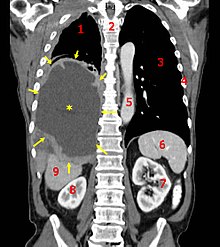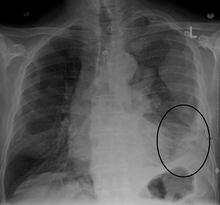Society and culture -2011
Notable cases
Mesothelioma, though rare, has had a number of notable patients.- Malcolm McLaren, former manager of New York Dolls and Sex Pistols, died on 8 April 2010.
- Billy Vaughn, American bandleader, died in 1991.
- Hamilton Jordan, Chief of Staff for U.S. President Jimmy Carter and lifelong cancer activist, died in 2008.
- Richard J. Herrnstein, psychologist and co-author of The Bell Curve, died in 1994.
- Australian anti-racism activist Bob Bellear died in 2005.
- British science fiction writer Michael G. Coney, responsible for nearly 100 works, also died in 2005.
- American film and television actor Paul Gleason, perhaps best known for his portrayal of Principal Richard Vernon in the 1985 film The Breakfast Club, died in 2006.
- Mickie Most, an English record producer, died of mesothelioma in 2003.
- Paul Rudolph, American architect, died in 1997.
- Bernie Banton, an Australian workers' rights activist, fought a long battle for compensation from James Hardie after he contracted mesothelioma after working for that company. He claimed James Hardie knew of the dangers of asbestos before he began work with the substance making insulation for power stations. Mesothelioma eventually took his life along with his brothers and hundreds of James Hardie workers. James Hardie made an undisclosed settlement with Banton only when his mesothelioma had reached its final stages and he was expected to have no more than 48 hours to live. Australian Prime Minister Kevin Rudd mentioned Banton's extended struggle in his acceptance speech after winning the 2007 Australian federal election.
- Actor Steve McQueen was diagnosed with peritoneal mesothelioma on December 22, 1979. He was not offered surgery or chemotherapy because doctors felt the cancer was too advanced. McQueen subsequently sought alternative treatments at clinics in Mexico. He died of a heart attack on November 7, 1980, in Juárez, Mexico, following cancer surgery. He may have been exposed to asbestos while serving with the U.S. Marines as a young adult—asbestos was then commonly used to insulate ships' piping—or from its use as an insulating material in automobile racing suits (McQueen was an avid racing driver and fan).[40]
- United States Congressman Bruce Vento died of mesothelioma in 2000. The Bruce Vento Hopebuilder award is given yearly by his wife at the MARFSymposium to persons or organizations who have done the most to support mesothelioma research and advocacy.
- Rock and roll musician and songwriter Warren Zevon, after a long period of untreated illness and pain, was diagnosed with inoperable mesothelioma in the fall of 2002. Refusing treatments that he believed might incapacitate him, Zevon focused his energies on recording his final album The Wind, including the song "Keep Me in Your Heart," which speaks of his failing breath. Zevon died at his home in Los Angeles, California, on September 7, 2003.
- Christie Hennessy, the influential Irish singer-songwriter, died of mesothelioma in 2007, and had stridently refused to accept the prognosis in the weeks before his death.[41] Hennessy's mesothelioma has been attributed to his younger years spent working on building sites in London.[42][43]
- Bob Miner, one of the founders of Software Development Labs, the forerunner ofOracle Corporation, died of mesothelioma in 1994.
- Scottish Labour MP John William MacDougall died of mesothelioma on August 13, 2008, after fighting the disease for two years.[44]
- Australian journalist and news presenter Peter Leonard of Canberra succumbed to the condition on September 23, 2008.
- Terrence McCann, Olympic gold medalist and longtime Executive Director ofToastmasters, died of mesothelioma on June 7, 2006, at his home in Dana Point, California.
- Merlin Olsen, Pro Football Hall of Famer and television actor, died on March 10, 2010, from mesothelioma that had been diagnosed in 2009.
Notable people who have lived for some time with mesothelioma
Although life expectancy with this disease is typically limited, there are notable survivors. In July 1982, Stephen Jay Gould was diagnosed with peritoneal mesothelioma. After his diagnosis, Gould wrote "The Median Isn't the Message"[45] for Discover magazine, in which he argued that statistics such as median survival are just useful abstractions, not destiny. Gould lived for another 20 years, eventually succumbing to metastatic adenocarcinoma of the lung, not mesothelioma. Author Paul Kraus was diagnosed with peritoneal mesothelioma in July 1997. He was given a prognosis of less than a year to live and used a variety of complementary modalities. He continues to outlive his prognosis and wrote a book about his experience "Surviving Mesothelioma and Other Cancers: A Patient's Guide"[46] in which he presented his philosophy about healing and the decision making that led him to useintegrative medicine.Legal issues
Main article: Asbestos and the law
The first lawsuits against asbestos manufacturers were in 1929. Since then, many lawsuits have been filed against asbestos manufacturers and employers, for neglecting to implement safety measures after the links between asbestos, asbestosis, and mesothelioma became known (some reports seem to place this as early as 1898). The liability resulting from the sheer number of lawsuits and people affected has reached billions of dollars.[47] The amounts and method of allocating compensation have been the source of many court cases, reaching up to the United States Supreme Court, and government attempts at resolution of existing and future cases. However, to date, the US Congress has not stepped in and there are no federal laws governing asbestos compensation.[48]- History
In the town of Wittenoom, asbestos-containing mine waste was used to cover schoolyards and playgrounds. In 1965 an article in the British Journal of Industrial Medicine established that people who lived in the neighbourhoods of asbestos factories and mines, but did not work in them, had contracted mesothelioma.
Despite proof that the dust associated with asbestos mining and milling causes asbestos-related disease, mining began at Wittenoom in 1943 and continued until 1966. In 1974 the first public warnings of the dangers of blue asbestos were published in a cover story called "Is this Killer in Your Home?" in Australia's Bulletin magazine. In 1978 the Western Australian Government decided to phase out the town of Wittenoom, following the publication of a Health Dept. booklet, "The Health Hazard at Wittenoom", containing the results of air sampling and an appraisal of worldwide medical information.
By 1979 the first writs for negligence related to Wittenoom were issued against CSR and its subsidiary ABA, and the Asbestos Diseases Society was formed to represent the Wittenoom victims.
In Leeds, England the Armley asbestos disaster involved several court cases against Turner & Newall where local residents who contracted mesothelioma claimed compensation because of the asbestos pollution from the company's factory. One notable case was that of June Hancock, who contracted the disease in 1993 and died in 1997
Diagnosis

CT scan of a patient with mesothelioma, coronal section (the section follows the plane that divides the body in a front and a back half). The mesothelioma is indicated by yellow arrows, the central pleural effusion (fluid collection) is marked with a yellow star. Red numbers: (1) right lung, (2) spine, (3) left lung, (4) ribs, (5) descending part of the aorta, (6) spleen, (7) left kidney, (8) right kidney, (9) liver.

Micrographs showing mesothelioma in a core biopsy.
Generally, a biopsy is needed to confirm a diagnosis of malignant mesothelioma. A doctor removes a sample of tissue for examination under a microscope by a pathologist. A biopsy may be done in different ways, depending on where the abnormal area is located. If the cancer is in the chest, the doctor may perform a thoracoscopy. In this procedure, the doctor makes a small cut through the chest wall and puts a thin, lighted tube called a thoracoscope into the chest between two ribs. Thoracoscopy allows the doctor to look inside the chest and obtain tissue samples. Alternatively, the chest surgeon might directly open the chest (thoracotomy). If the cancer is in the abdomen, the doctor may perform a laparoscopy. To obtain tissue for examination, the doctor makes a small incision in the abdomen and inserts a special instrument into the abdominal cavity. If these procedures do not yield enough tissue, more extensive diagnostic surgery may be necessary.
Immunohistochemical studies play an important role for the pathologist in differentiating malignant mesothelioma from neoplastic mimics. There are numerous tests and panels available. No single test is perfect for distinguishing mesothelioma from carcinoma or even benign versus malignant.
| Positive | Negative |
| EMA (epithelial membrane antigen) in a membranous distribution | CEA (carcinoembryonic antigen) |
| WT1 (Wilms' tumour 1) | B72.3 |
| Calretinin | MOC-3 1 |
| Mesothelin-1 | CD15 |
| Cytokeratin 5/6 | Ber-EP4 |
| HBME-1 (human mesothelial cell 1) | TTF-1 (thyroid transcription factor-1) |


No comments:
Post a Comment